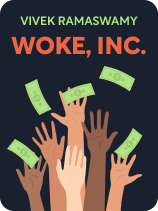

This article is an excerpt from the Shortform book guide to "Woke, Inc." by Vivek Ramaswamy. Shortform has the world's best summaries and analyses of books you should be reading.
Like this article? Sign up for a free trial here.
What is Vivek Ramaswamy’s “Wokenomics”? What are the dangers of progressive politics?
Entrepreneur Vivek Ramaswamy argues that corporations have devised an elaborate scam: advertising a hollow fight for social justice in order to reap unprecedented profit and power. Ramaswamy calls this fusion of progressive ideals and capitalism Wokenomics.
Read on for an overview of Ramaswamy’s Wokenomics, including why companies use it for profit.
What Is “Woke”?
Ramaswamy uses woke in his term, Wokenomics, as the summation of all progressive politics, particularly ones regarding marginalized identities. However, the definition of woke has fluctuated over the years. Originally, the word woke was used exclusively in Black communities as a steady reminder to be alert to anti-Blackness, but it didn’t have any particular political affiliation. When the Black Lives Matter movement introduced woke to the mainstream, the use of the word expanded, and people on both sides of the political lines have difficulty agreeing on a precise definition. The meaning of woke ranges from being synonymous with an age of enlightenment (people awakening to the causes of inequity) to an insult of people who are oversensitive and self-important (cancel culture and political correctness often fall toward this end of the spectrum).
(Shortform Note: The Black Lives Matter (BLM) movement is a response to the accumulating cases of police brutality against Black Americans and began after the murder of George Floyd. Because demonstrations were so widespread and conducted largely through social media, premise numbers of participants are hard to pin down, but recent polls suggest that BLM is the largest civil rights protest in American history.)
How Did Woke Become Wokenomics?
Ramaswamy argues that Wokenomics emerged when companies discovered they could boost their profits by claiming to fight for social justice. This discovery came during a significant cultural shift after the 2008 recession: The blame for American inequality moved from economic policy to systemic racism. So-called “Big Business” has always been characterized by greed and corruption, and that was true in 2008 when Americans were frustrated and distrustful (of banking companies especially). Desperately needing to improve their image, companies learned to capitalize on two key ideas developing at the time: stakeholder capitalism and Critical Race Theory.
| Companies Have Long Been Politically Involved The emergence of stakeholder capitalism and Critical Race Theory indeed correlates with CEOs being more vocal about their beliefs, and Ramaswamy wants to return to a time when capitalists kept these beliefs out of their companies. However, some historians argue that companies were never apolitical—even in regard to social issues. Political journalist Helen Lewis observes that as society evolves, it’s almost always more profitable for companies to adapt to new perspectives. With the rise of unions in the 1950s, many factories gave in to the demands to raise wages and improve working conditions for lower-class men. In the 1980s, several companies advocated for affirmative action to the Supreme Court. These corporate decisions aligned with the social movements at the time, but companies weren’t viewed as politically radicalizing. Each policy change led to monetary value for the company. Similar to Ramaswamy, Lewis argues that most companies have never had real interest in creating meaningful social reform, but unlike him, she argues that it’s because capitalism itself will never be the solution to social equality. |
Stakeholder Capitalism
Ramaswamy argues that Wokenomics came of age with the rise of stakeholder capitalism. Under the conventional corporate model, a CEO makes decisions based on the monetary benefit to the business and its shareholders. Stakeholder capitalism adds the consideration of all stakeholders to the mix, so that corporate executives also consider the good of the company’s employees and the community in which the company operates when making business decisions.
Ramaswamy observed stakeholder capitalism gaining traction after the major banks’ irresponsible practices led to the 2008 recession. Banks made loans to people who could not afford to pay them off, and after their actions came to light, the public began to question how we can prevent the same mistakes from happening again. Stakeholder capitalism provided an answer. Theoretically, if companies valued people and community as much as they did their money, then they would not exploit their customers again.
| How Does Stakeholder Capitalism Benefit Companies? Besides improving consumer trust, there are other profitable reasons for companies to buy into stakeholder capitalism. – When companies invest money into social causes, their business becomes indispensable. If a company creates a community program, consumers and politicians know that the program loses funding if the company goes under. – Companies that support social causes attract a new generation of workers. Generation Z in particular has come to value social responsibility. The young people who are active in their community and knowledgeable about political issues will most likely be the most innovative and intelligent employees entering the workforce. – If an employee feels passionately about social causes, they will dedicate time and energy toward those causes. When a company provides a way for an employee to fulfill this passion, then their efforts can be spent at work instead of through other organizations. – Similarly, consumers who care about social issues can develop a sense of loyalty to a company and tend to be vocal about their approval online. Social media is necessary for the growth of a company but notoriously tricky to navigate. A devoted customer base can help protect companies from potential PR mistakes or cancel culture. – Premium products that support social causes justify higher prices. |
The move toward social consciousness was also reinforced by the government’s response to the banks’ misconduct. After the recession, the government required banks to pay fines, with the intention of using those funds to help the people who fell on hard times. However, the Department of Justice also offered an alternative: If companies didn’t want to pay the fine, they could donate to an approved list of non-profits for a lesser amount of money with the usual tax deductions. Many corporations took advantage of this, and as a result, diverted funds that would have otherwise directly helped the American people. In addition, they generated positive publicity for being socially conscious. For example, after the recession, Bank of America ironically began a fund for nonprofits that aided in establishing financial stability through homebuyer education, budgeting, and other related programs.
Ramaswamy declares that through the rising popularity of stakeholder capitalism, corporations gained a larger say in our political discourse. Because corporations have money and recognition beyond the average citizen, their political influence can potentially outweigh that of an American citizen.
| Limitations of Stakeholder Capitalism Ramaswamy argues that unless consumers stop demanding sustainable and inclusive business practices, stakeholder capitalism is going to become the norm in our economy. Other political commentators agree with him, warning of significant limitations to the benefits of such a system. – Realistically, companies have finite resources to use on social causes. How companies will choose which cause to prioritize is unclear. It may be tempting for companies to choose easier or less significant social causes so that they can appear socially conscious without having to invest much effort into more difficult change. – When companies face financial hardship, the social causes they support will suffer. If our society becomes too reliant on companies to fight social causes, economic recessions can intensify the threats to high-risk communities. Some advocates of stakeholder capitalism recommend that companies committed to social justice should take the time to educate themselves on the best ways to generate positive change and to avoid becoming monopolies through partnerships with other organizations. It’s also important to note that many activists such as Malcolm X and Fred Hampton argue that capitalism is inherently predatory, and social equality is not compatible with any capitalist system. |
Critical Race Theory
Ramaswamy claims Wokenomics also coincided with the emergence of Critical Race Theory (CRT), which centers racism as the blame for inequalities in America. CRT is an academic concept created by a group of lawyers and legal scholars in the 1990s. Their main principle is that race was a fundamental part of the conception of America—for example, through the genocide of indigenous peoples and the enslavement of Black people—and since the Constitution was created within this context of severe racial divide, lawyers can’t assume the legal system is neutral and must recognize the ways in which racism still operates in our legislation.
(Shortform note: In its original academic context, CRT isn’t meant to be used in isolation—it’s one of many approaches activists advise be used to analyze legislation (or other social structures, depending on the field that adapts the theory). Kimberle Crenshaw, one of the lawyers credited with CRT, emphasized the importance of intersectionality: the understanding that people have different identities, of which race is just one, and which can overlap but are still distinct. For example, while a poor, Black woman may share some experiences as a Black, transgender man because of their race, they will also have dissimilarities due to their unique identities.)
However, Ramaswamy compares the belief in systemic racism to accepting a racial caste system, in which some groups have more rights and advantages than others. He doesn’t believe such a caste-like system exists in America and that woke people pressing for diverse inclusion are actually vying for extra privileges they didn’t earn. He is particularly against prioritizing inclusion in the workplace, as it may lead companies to hire people based on their identities instead of their qualifications.
(Shortform note: American journalist Isabel Wilkerson also compares systemic racism in America to a caste system in her book Caste. She argues that similar to caste systems in other countries, groups of people are granted certain privileges while others are disenfranchised, and this dichotomy is upheld by legislation and social norms. However, her solution to breaking the caste system is not to deny its existence but to examine the ways in which the racial structure is maintained and fight against it.)

———End of Preview———
Like what you just read? Read the rest of the world's best book summary and analysis of Vivek Ramaswamy's "Woke, Inc." at Shortform.
Here's what you'll find in our full Woke, Inc. summary:
- Tactics companies use to influence legislation and manipulate consumers
- How "Wokenomics" is weakening democracy
- Five solutions to counter wokeness






